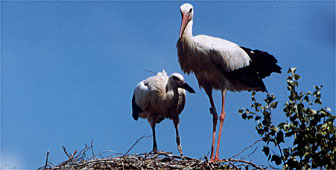Swiss seek to prevent extinction of storks

Next week 25 storks carrying backpacks will begin flying south from towns all over Switzerland. With the birds' help, researchers hope to learn what is killing hundreds of migrating storks before they can return to Switzerland to breed.
Unless the mystery is solved soon, Swiss storks will die out completely, officials for the project “SOS Stork” say.
The storks’ 52-gramme backpacks are solar-powered transmitters, the initial part of a telemetry system. Their signals will be received by three satellites and relayed to biologist Adrian Aebischer in Fribourg, giving him the location of each stork.
Aebischer will be working closely with Holger Schulz, the leader of the four ground teams, which will be following the storks from Switzerland to Africa over the next two months.
While the ground teams are following the 25 birds, stork enthusiasts will be able to follow the birds’ progress on their computers.
Ornithologists have already been keeping track of Max, the project’s pilot stork, who acquired his transmitter in July 1999. Last year Max flew from Avenches to Morocco, where he spent the winter, and now he’s near Madrid. If he survives, he will return to Switzerland in two or three years to breed.
There are two colonies of European storks. One group summers in Eastern Europe and winters between Sudan and South Africa. Swiss storks belong to the other, western, colony. They are born in Switzerland in May and leave in mid-August to fly south in flocks, following updrafts across France and Spain to winter on the southern edge of the Sahara.
After three or four years, the young storks return to the European region of their birth to breed, and, from then on, a stork pair will come back to the same town – and if possible, the same nest – to breed every year.
Storks born in Switzerland are marked with an identification ring around one leg. Because they are ringed as babies, experts know that only 10 per cent of them are currently returning to breed. The rest are apparently dying before they can mate, which means that Switzerland is in danger of losing all its storks.
Fifty years ago, the Swiss stork population was down to one single pair. A man from Solothurn, Max Blösch, recognised the emergency and made it his life’s work to give Switzerland back its storks.
In Altreu, a village near Solothurn, he found gamekeeper Arnold Hieri, who was willing to donate his land and his time to Blösch’s project: importing storks to repopulate the region.
Altreu has since become a Swiss haven for storks. Today scores of storks can be seen there from April to September, raising their young in trees and on rooftops.
The Swiss Society for the White Stork, whose 3,000 members are dedicated to improving the birds’ living conditions, runs a centre in Altreu to educate visitors about storks and their habitats.
Peter Enggist, head of the society, and his wife Margrit have worked tirelessly for “SOS Stork”, raising money from numerous sponsors, including Migros and Crossair, and hiring project leader Schulz. The Natural History Museum in Fribourg is also behind the project.
“We’re not interested in scientific laurels,” said Schulz. “This is primarily a conservation project. We need to find out why storks are dying and, once we do, work to reduce the threats they face during migration.”
Schulz explained that the main dangers are hunters, collisions with electric wires, and the destruction of wetlands and other natural habitats where the storks feed during their migration and in Africa. Researchers hope to know more as they track the birds from Switzerland to Africa and investigate each death.
by Kim Hays

In compliance with the JTI standards
More: SWI swissinfo.ch certified by the Journalism Trust Initiative








You can find an overview of ongoing debates with our journalists here . Please join us!
If you want to start a conversation about a topic raised in this article or want to report factual errors, email us at english@swissinfo.ch.